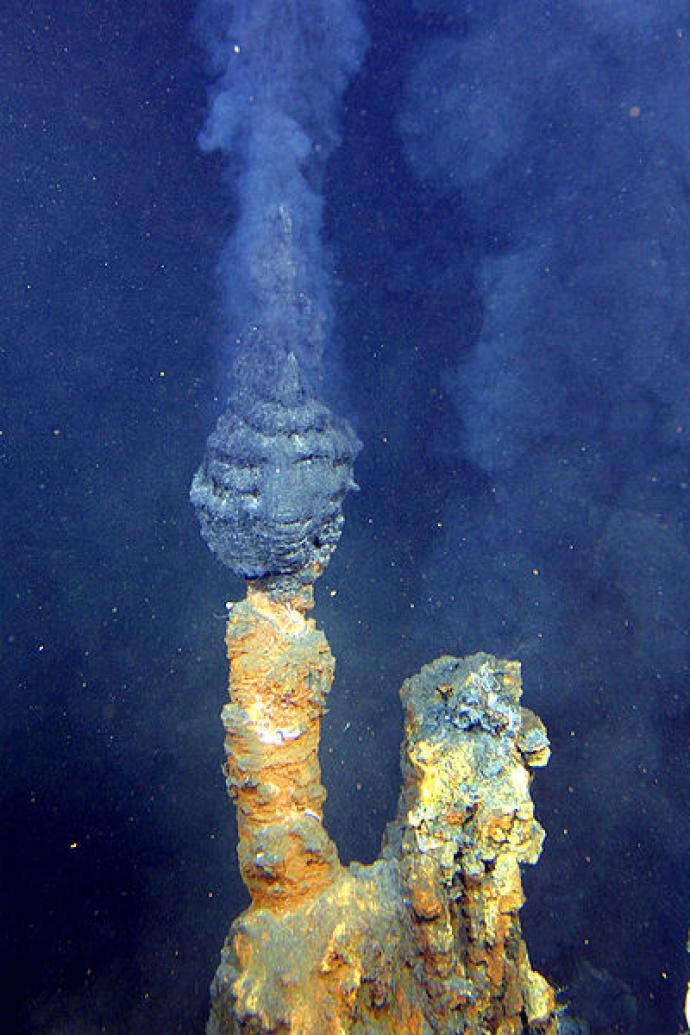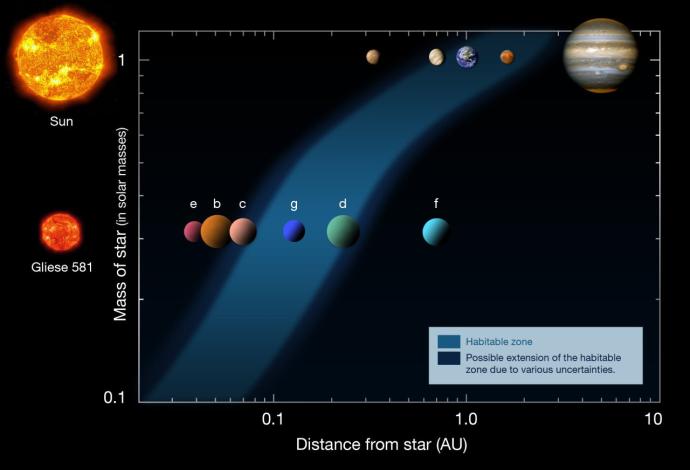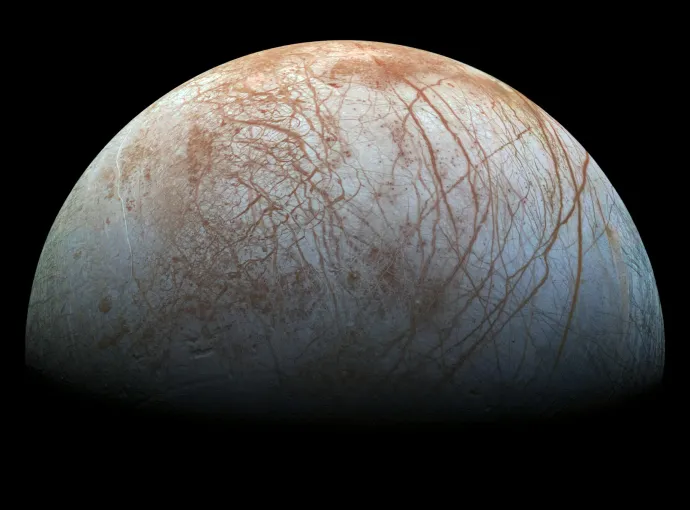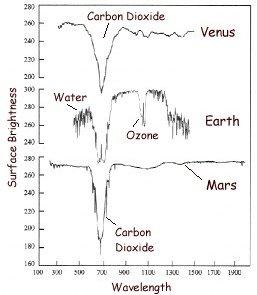Astrobiologists believe that three ingredients which are vital for life. They are water, energy, and organic molecules such as carbon (C). Energy and organic molecules are abundant in the Universe. But liquid water is rare.
Water on Earth is in its liquid form at sea-level, where temperatures are 0 °C - 100 °C. But, the Earth has geographical, seasonal, and daily variations. These variations can drive temperatures down to well below freezing. Then, water is found as ice. Temperatures in Antarctica can reach as low as -89 °C, yet life can still survive there.
Most terrestrial (land-based) organisms can't survive temperatures above 45 °C for long. Yet some marine life can. Thermophiles have been found thriving around hydrothermal vents (black smokers). These are found in the deepest parts of the ocean. Here, pressures are extreme and temperatures exceed 110 °C.
It is important to understand the extreme conditions in which life can survive on Earth. But, we should not let this limit where we expect to find life in the rest of the universe. Life may have evolved in unique ways. Like the ability to 'breathe' other atmospheres.

- The Habitable Zone (HZ)
A habitable zone (HZ) is the area around a star where liquid water could exist on or near the surface of a planet. We call it an HZ because we believe liquid water is vital for the existence of life.
An HZ is sometimes called a CHZ, where the C stands for 'continuously' or 'circumstellar'. The name Goldilocks Zone is perhaps a more useful way to describe an HZ. It is a region that is not too hot, and not too cold, but just right! The size and location of an HZ depend on the size and type of the star.
In our Solar System, the HZ stretches from just outside Venus' orbit to just inside that of Mars, which includes Earth. Hot, bright stars like Sirius have wide HZs. Sirius is 26 times brighter than the Sun. If our Earth was in orbit around Sirius, it would have to be much further away from the star to enjoy the same temperatures. In fact, it would have to be at about the same distance as Jupiter is from the Sun.
In contrast, if the Earth were in orbit around a much dimmer star, like 40 Eridani it would need to be much closer. The Earth would need to be in a Venus-like orbit to receive its present level of warmth.
Image CreditThis work by NASA/JPL is licensed under Creative Commons Zero v1.0 Universal
CreditThis work by NASA/JPL is licensed under Creative Commons Zero v1.0 UniversalDiagram of the habitable zone around the Sun and 40 Eridani However, just because a planet is in an HZ does not mean that liquid water exists there. For example, a planet's atmosphere or cloud cover can affect its surface temperature. And we cannot assume that every world outside an HZ cannot sustain life.
Moons that are outside an HZ may have other sources of heat which allow liquid water to exist. For example, Jupiter's tidal forces produce heat on some of its moons.
This makes the big question for planetary scientists and astrobiologists: "How special is Earth?" Are there other places where life can survive? For now, looking for exoplanets in an HZ seems like a sensible approach There are 200 million stars in our galaxy. Imagine one in a thousand had a small rocky planet. They have a stable orbit within the star's HZ. That would mean 200,000 planets where life might exist.
Image CreditThis work by ESO/L. Calçada is licensed under Creative Commons Zero v1.0 Universal
CreditThis work by ESO/L. Calçada is licensed under Creative Commons Zero v1.0 UniversalThe habitable zone and planets around the Sun and Gliese 581 align= - Life in the Solar System
We have mentioned life around other stars. But, there is a chance that life may exist out in our own Solar System. The discovery of primitive life, or fossils, on Mars would extend the HZ of the Sun.
In fact, evidence shows that Mars was once warmer and wetter. These conditions may have allowed primitive organisms to evolve. Ongoing and future missions to Mars will search for these signs of life.
Much further from the Sun are the gas giants. Planets like Jupiter and their large moons. At first sight these moons may seem inhospitable to life. However, the moons Europa and Callisto are subject to tidal heating. This may lead to the existence of large amounts of sub-surface liquid water. This would increase the likelihood of aquatic life.
Click here to find out how astronomers are looking for extra-terrestrial life.
Image CreditThis work by NASA/JPL-Caltech/SwRI/MSSS is licensed under Creative Commons Zero v1.0 Universal
CreditThis work by NASA/JPL-Caltech/SwRI/MSSS is licensed under Creative Commons Zero v1.0 UniversalThe frozen surface of Europa may cover liquid oceans - Locating Life: (1) Atmospheric Biomarkers
Is there life on other planets? To find out, scientists have developed novel ways to search for life on other planets. Searching within our own Solar System and beyond. One of the techniques they use is Atmospheric Biomarkers.
to understand Atmospheric Biomarkers, let's compare the atmospheres of Earth, Venus, and Mars. We can do this by looking at the spectrum of the light which is reflected from their atmospheres.
The spectrum tells us which gases make up each atmosphere. We can then tell that the atmospheres of Venus and Mars are distinct from Earth. Both Venus and Mars show evidence of carbon dioxide in their atmospheres. Earth's atmosphere also has some carbon dioxide. But, it also contains ozone and water. Ozone is a by-product of oxygen (O2).
Finding large amounts of ozone means that there are large amounts of O2. Some scientists believe that large amounts of O2 can only be produced by the process of photosynthesis. This process is driven by plants and trees on land, and tiny plants called phytoplankton in the oceans. This means that if we discover a planet with ozone in the spectrum of its atmosphere, we might find life on it.
Space telescopes are being designed to look for ozone in the atmospheres of distant planets. Gasses like ozone tell us if there is likely to be life on a planet. We call indicators like these biomarkers.
Biomarkers mark the likely presence of biology or life. Of course, biomarker gases such as ozone only relate to life as we know it. We have to remember that extra-terrestrial life may not be what we expect. Alien life may not require O2. In fact, there is life in the deep ocean which survives without O2.
Image CreditThis work by The Schools' Observatory is licensed under All rights reserved
CreditThis work by The Schools' Observatory is licensed under All rights reservedSpectra of Venus, Earth and Mars - Location Life: (2) SETI (Search for Extra-Terrestrial Intelligence)
Another technique that scientists use to search for life on other planets is SETI (Search for Extra-Terrestrial Intelligence).
The SETI programme is a global project. It employs more than 100 scientists, educators and support staff. They are dedicated to searching for signals. Signals from advanced alien species from distant planets.
In truth, we don't know what an alien signal will be like. It is likely that they will have more advanced technology than us. It is hard for us to imagine their thought processes. Or their reasons and methods for interacting with us. All we can do is make some educated guesses. Guesses based on our own knowledge and technology.
SETI's first assumption is about the frequency of a first signal. We think it will be at or around the frequency of 1420 MHz. This is the spectral frequency of Hydrogen. It is the most common element in the universe. This means it may be a universal reference point for other intelligent species.
To detect strong signals at this wavelength, SETI uses radio telescopes around the world. One of those is the Allan Telescope Array (pictured). This is used to scan the night sky. Some telescopes have targeted nearby stars to try and detect signals beamed in our direction. To learn more about the SETI programme, click here.
Image CreditThis work by Colby Gutierrez-Kraybill is licensed under Creative Commons Attribution 4.0 International
CreditThis work by Colby Gutierrez-Kraybill is licensed under Creative Commons Attribution 4.0 InternationalA radio telescope used by SETI
